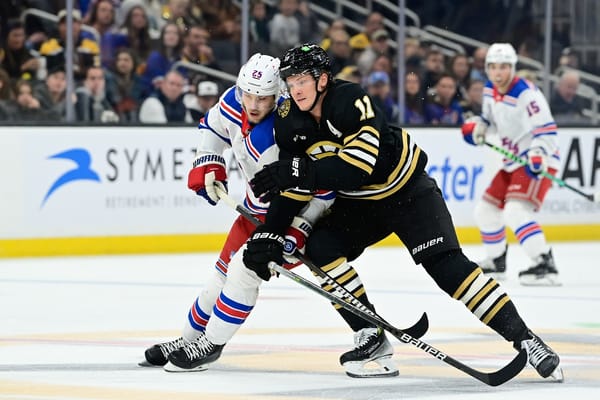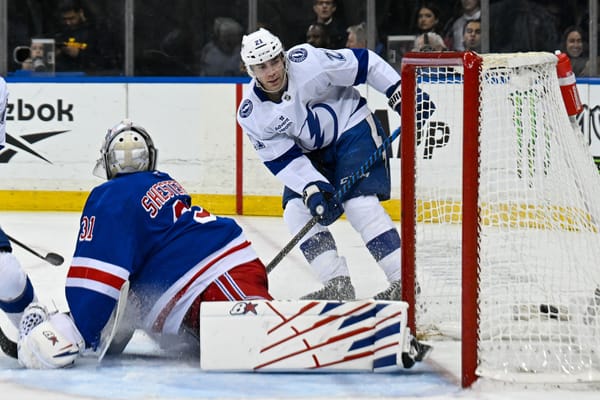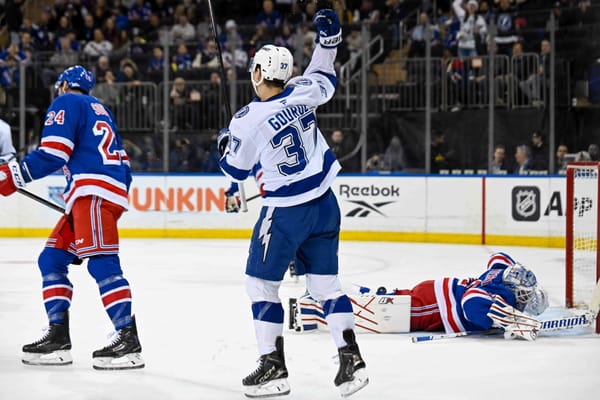What Have We Learned? A Look at Games 22-24
We left off with the New York Rangers shutting out the Ottawa Senators last Sunday. Since then, the Rangers traveled to Carolina and faced off against both the Detroit Red Wings and Vancouver Canucks at home. Three wins later and the Rangers are on a four-game win streak and have won eight straight games at Madison Square Garden.
On Wednesday, the Rangers matched up against the Hurricanes without their captain Ryan McDonagh. Steven Kampfer drew back in and returned to the third pair with Staal. Brendan Smith and Nick Holden made up the second pair, while Brady Skjei and Kevin Shattenkirk led the way as the first pair. The forward lines that were deployed last Sunday were once again utilized, and were (for the most part) maintained throughout the week.
Chris Kreider opened the scoring early in the first period; less than two minutes later, Mika Zibanejad gave the Rangers a 2-0 lead. Sebastian Aho cut the lead in half with a power play goal, but Paul Carey’s first goal of the season restored the Rangers’ two-goal lead. After a scoreless second period, Kreider scored his second goal of the night and Jesper Fast added two of his own. Four defensemen (Smith, Kampfer, Holden, and Skjei) contributed to the Rangers scoring with an assist each. Lundqvist stopped 32 of the 33 shots he faced.
The Rangers returned to the Garden Friday night for a tilt against the Red Wings. Both goaltenders, Jimmy Howard (stopped 29 of 31 shots, 5-on-5 1.83 goals saved above average) and Lundqvist (stopped 40 of 41 shots, 5-on-5 2.64 GSAA), shined in this game. Neither allowed a goal in the first 40 minutes. Tomas Tatar scored the first goal of the night on the power play in the third period. Kreider tied the game soon after, assisted by Pavel Buchnevich and Brady Skjei. Then in overtime, J.T. Miller and Skjei assisted Mats Zuccarello in scoring the game-winning goal.
Lundqvist led his team Sunday afternoon versus the Vancouver Canucks as well. The Canucks scored first, with an even-strength Loui Eriksson goal that was the first even-strength goal allowed by Lundqvist since their November 17th loss to the Blue Jackets. After the Canucks added another goal in the second to put the Rangers at a 2-0 deficit, Fast scored to pull his team within one. Grabner tied the game 19 seconds into the third period. Less than a minute later, the Canucks pulled ahead again. Soon after, Jimmy Vesey tied the game 3-3, where it remained until the shootout, when Vesey scored the game-winning goal.
So what have we learned? This week the Rangers got secondary scoring from an unlikely source: Jesper Fast. Fast is quietly effective on both sides of the ice, but he doesn’t usually end up on the scoresheet. He specializes in a defensive style that makes him an invaluable piece to the Rangers bottom-six and penalty kill. But when the Rangers needed an offensive boost this week, he provided it. In his last three games, he scored three goals – two against the Hurricanes for the first two-goal night of his career and one against the Canucks.
Maybe it’s the fact that he’s playing alongside more offensive linemates in Nash and Kevin Hayes that’s boosting his offense, or maybe he has this untapped offensive upside that he’s yet to show (okay, that’s less likely). Fast probably isn’t going to continue to score at his team-leading rate of 2.13 5-on-5 points per hour, but while it continues, keeping him on the second line makes sense. When this offense dries up, which will inevitably happen (and that’s okay, because it’s not Fast’s game), it’s important that the Rangers adjust the lineup accordingly instead of trying to force something that isn’t there. So for now, those offensive contributions are certainly appreciated from a player that’s better known for his play on the other side of the ice.
Another player that scored three goals this week was Kreider. Kreider also scored two in Carolina and added one against the Red Wings. For the 5-on-5 minutes he’s deployed, Kreider can be considered to be overused because his production doesn’t match his usage on the surface. While he’s a positive influence on the team’s offensive generation, as evidenced by his plus-4.44 relative Corsi and plus-6.63 relative goals for percentage, the scoresheet has yet to reflect that. Before this week, he only had two even-strength goals (only one of which was at 5-on-5). As much as he’s been a key component of the power play, the Rangers need more contributions at even-strength.
Kreider’s expected to be a leading scorer on this team. While his tangible results haven’t been as strong, he’s a crucial piece of the Rangers’ best combination – KZB. The KZB combination is dangerous almost every shift at even-strength and on the man-advantage. If they continue to develop chemistry, more results, like Kreider’s three goals this week, should come.
Then there’s the issue of the bottom-six. Costly defensive mistakes often led to David Desharnais being benched through the third periods of games, until it eventually led to him being scratched last week. Once he was scratched, Miller shifted to center on the third line and Paul Carey returned to the lineup on the fourth line wing. Boo Nieves’s injury in the game against Detroit gave Desharnais the opportunity to prove himself on Sunday, though that chance was also limited. After being on the ice for two goals against, Desharnais only saw one shift after Jake Virtanen’s second period goal. Paul Carey was also on the ice for two goals against and didn’t see much ice time after that Virtanen goal either (four shifts in the remainder of the game).
Desharnais has made a number of defensive mistakes this season. He has a minus-7.04 relative Corsi and minus-10.94 relative expected goals despite some of the most favorable zone starts. Coaches are often primarily concerned with goals. Well, Desharnais has been on the ice for a number of goals against, and his goals for percentage of 38.1 is a minus-8.78 relative to his teammates. The Rangers may be reconsidering his place in the lineup, especially if Miller and Nieves can handle the center of the ice. The problem, though, is that the team doesn’t exactly have center depth behind Miller and Nieves. And as long as Nieves is injured, they need Desharnais to stay in the lineup if they don’t have option in the AHL – unless of course the team prefers rolling 11 forwards and seven defensemen, but we all saw how well that worked out.
When the Rangers rolled 11 forwards and seven defensemen, the extra forward the Rangers could have deployed was Carey, but the coaches often opted against utilizing him and waited until Nieves was recalled to use 12 forwards again. Somehow, Carey’s drawn back into this lineup, albeit towards the bottom of the ice time charts. While he may have scored against the Hurricanes, he hasn’t done much else to warrant a place in the lineup other than being a body that theoretically allows the team to use 12 forwards – at least through two periods. Since returning to the lineup, his play hasn’t been too encouraging, so it remains to be seen why Carey is the 12th forward instead of someone from Hartford like Vinni Lettieri.
Shifting to defense, the Rangers were without McDonagh all week due to a lingering injury, which required the rest of the defense to take on expanded roles. Holden interestingly led the team in ice time in Carolina, while Shattenkirk only finished with 18:28 minutes in total. There weren’t as many power play opportunities, which explains his ice time not reaching its usual heights, but it doesn’t explain why he didn’t receive more even-strength time.
By Friday though, the ice times made more sense, with Shattenkirk receiving slightly more time (19:07), Smith moving up to 20:47, and Skjei leading the way with 22:16. Holden finished second with 21:41, but he did have to spend more time short-handed as Smith was penalized twice. Then on Sunday, Skjei (27:49) and Shattenkirk (25:30) led the team in ice time, followed by Smith (19:41) and Holden (17:40); Staal and Kampfer rightfully received the least time.
These games without McDonagh hopefully have given some clarity into which defensemen belong in the lineup moving forward and which don’t. Kampfer’s Corsi relative to his teammates was a minus-10.08 on Wednesday, then a minus-10.66 against Detroit, and minus-24.35 against Vancouver. If this week wasn’t indicative enough, what will be?
Holden has been serviceable, although it’s not clear where in this lineup he belongs quite yet, though the answer still isn’t on the first pair with McDonagh. Staal has improved a lot this year and should maintain his third pair role. Smith has proved himself since returning to the lineup, and over the last three games has steadily increased his ice time. Shattenkirk still isn’t consistently receiving top-pair ice time and he should still get a chance on McDonagh’s right once he returns.
And then there’s Skjei. Skjei has absorbed McDonagh’s role for the time being and he’s done it quite well, particularly in the last two games. He earned a primary assist on Zibanejad’s goal in Carolina, plus two assists against the Red Wings – one of which was on the game-winning goal in overtime.
Skjei had a plus-8.17 relative Corsi on Friday, then a plus-3.93 on Sunday. As for special teams, he’s continued on the second power play unit and added more short-handed time, although he may be deserving of more short-handed opportunities. More time on the penalty kill could further facilitate his development into an all-around defenseman like McDonagh, which would come in handy if the Rangers do choose to trade him for assets next season. Skjei was up to the task when asked to take on a more challenging role and helped lessen the blow of losing McDonagh.
Lastly, there’s Lundqvist in net. Again this season, Lundqvist has been the Rangers backbone. Before Eriksson’s goal Sunday, Hank hadn’t allowed an even-strength goal since Zach Werenski scored on him on November 17. Between Werenski’s goal and Eriksson’s, he made 88 even-strength saves.
Sunday’s game ended one streak for Lundqvist, but continued another – starting his 12th consecutive game. And in those 12 games, he’s gone 10-2, which is definitely impressive and has merited more starting opportunities. The problem with that is that he’s on pace for 71.75 starts, which could present challenges later in the season.
While Lundqvist is still very capable of being a game-changer in the regular season and well into the postseason, he can’t lead the team to the Stanley Cup on his own. Leaning this heavily on him so soon into the season because the team got backed into a situation where they have to win now after their dismal start is a flawed strategy. The team has to improve defensively so they can support Lundqvist and facilitate Pavelec’s game when he’s utilized. And Pavelec needs some playing time too; if Lundqvist were to go down with an injury, the Rangers would be in trouble because they don’t yet have a backup they can rely on like they did with Cam Talbot and Antti Raanta. Pavelec could get to that point, but that requires more playing experience.
This week, the Rangers only have two games, both at home, against the Panthers and Hurricanes. The following week, they have three challenging games against the Penguins, Capitals, and Devils. Before they go into those must-win games, it’s important to give Lundqvist a night off. And it’s equally important to continue to improve this defense and overall, this team – even if they are winning games – in order to have sustainable, long-term success.
As important as wins are, adjusting and improving along the way is pivotal. The Rangers still have to improve a number of areas: their offensive production at even-strength, their defensive tactics, and their goaltender usage. And along the way, they need to assess this roster and establish whether there are flaws that should be addressed sooner rather than later. The idea of “rebuilding on the fly” was to stay competitive in front of Lundqvist. That still seems to be the goal, so in order to actually have a chance to do that, their goaltender needs some rest, their backup needs some experience, and this team has to grow into a contender as the season progresses.
*Data is at 5v5, via Corsica.hockey




